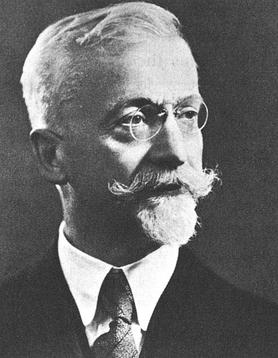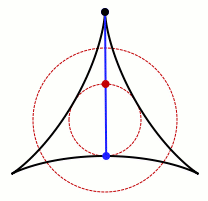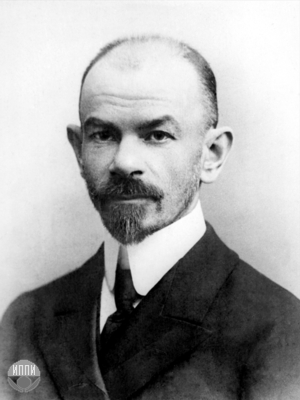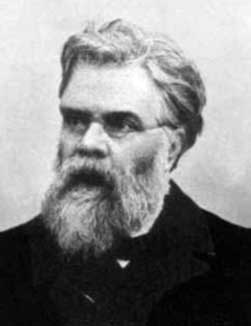Related Research Articles

Jules Henri Poincaré was a French mathematician, theoretical physicist, engineer, and philosopher of science. He is often described as a polymath, and in mathematics as "The Last Universalist", since he excelled in all fields of the discipline as it existed during his lifetime.

Henri Léon Lebesgue was a French mathematician known for his theory of integration, which was a generalization of the 17th-century concept of integration—summing the area between an axis and the curve of a function defined for that axis. His theory was published originally in his dissertation Intégrale, longueur, aire at the University of Nancy during 1902.

Adrien-Marie Legendre was a French mathematician who made numerous contributions to mathematics. Well-known and important concepts such as the Legendre polynomials and Legendre transformation are named after him.
In complex analysis, de Branges's theorem, or the Bieberbach conjecture, is a theorem that gives a necessary condition on a holomorphic function in order for it to map the open unit disk of the complex plane injectively to the complex plane. It was posed by Ludwig Bieberbach (1916) and finally proven by Louis de Branges (1985).

Élie Joseph Cartan was an influential French mathematician who did fundamental work in the theory of Lie groups, differential systems, and differential geometry. He also made significant contributions to general relativity and indirectly to quantum mechanics. He is widely regarded as one of the greatest mathematicians of the twentieth century.

In mathematics, a Kakeya set, or Besicovitch set, is a set of points in Euclidean space which contains a unit line segment in every direction. For instance, a disk of radius 1/2 in the Euclidean plane, or a ball of radius 1/2 in three-dimensional space, forms a Kakeya set. Much of the research in this area has studied the problem of how small such sets can be. Besicovitch showed that there are Besicovitch sets of measure zero.

Pierre Joseph Louis Fatou was a French mathematician and astronomer. He is known for major contributions to several branches of analysis. The Fatou lemma and the Fatou set are named after him.

Eugène Charles Catalan was a French and Belgian mathematician who worked on continued fractions, descriptive geometry, number theory and combinatorics. His notable contributions included discovering a periodic minimal surface in the space ; stating the famous Catalan's conjecture, which was eventually proved in 2002; and introducing the Catalan number to solve a combinatorial problem.

Édouard Jean-Baptiste Goursat was a French mathematician, now remembered principally as an expositor for his Cours d'analyse mathématique, which appeared in the first decade of the twentieth century. It set a standard for the high-level teaching of mathematical analysis, especially complex analysis. This text was reviewed by William Fogg Osgood for the Bulletin of the American Mathematical Society. This led to its translation into English by Earle Raymond Hedrick published by Ginn and Company. Goursat also published texts on partial differential equations and hypergeometric series.

In mathematics, arithmetic geometry is roughly the application of techniques from algebraic geometry to problems in number theory. Arithmetic geometry is centered around Diophantine geometry, the study of rational points of algebraic varieties.

Dmitri Fyodorovich Egorov was a Russian and Soviet mathematician known for contributions to the areas of differential geometry and mathematical analysis. He was President of the Moscow Mathematical Society (1923–1930).

Dimitrie D. Pompeiu was a Romanian mathematician, professor at the University of Bucharest, titular member of the Romanian Academy, and President of the Chamber of Deputies.
Alexandru Ghika was a Romanian mathematician, founder of the Romanian school of functional analysis.

Thierry Aubin was a French mathematician who worked at the Centre de Mathématiques de Jussieu, and was a leading expert on Riemannian geometry and non-linear partial differential equations. His fundamental contributions to the theory of the Yamabe equation led, in conjunction with results of Trudinger and Schoen, to a proof of the Yamabe Conjecture: every compact Riemannian manifold can be conformally rescaled to produce a manifold of constant scalar curvature. Along with Yau, he also showed that Kähler manifolds with negative first Chern classes always admit Kähler–Einstein metrics, a result closely related to the Calabi conjecture. The latter result, established by Yau, provides the largest class of known examples of compact Einstein manifolds. Aubin was the first mathematician to propose the Cartan–Hadamard conjecture.

Émile Michel Hyacinthe Lemoine was a French civil engineer and a mathematician, a geometer in particular. He was educated at a variety of institutions, including the Prytanée National Militaire and, most notably, the École Polytechnique. Lemoine taught as a private tutor for a short period after his graduation from the latter school.
Alexandru Froda was a Romanian mathematician with contributions in the field of mathematical analysis, algebra, number theory and rational mechanics. In his 1929 thesis he proved what is now known as Froda's theorem.
In mathematics, the Cartan–Hadamard conjecture is a fundamental problem in Riemannian geometry and Geometric measure theory which states that the classical isoperimetric inequality may be generalized to spaces of nonpositive sectional curvature, known as Cartan–Hadamard manifolds. The conjecture, which is named after French mathematicians Élie Cartan and Jacques Hadamard, may be traced back to work of André Weil in 1926.

Gheorghe Călugăreanu was a Romanian mathematician, professor at Babeș-Bolyai University, and full member of the Romanian Academy.
References
- Pompeiu, Dimitrie (1929), "Sur certains systèmes d'équations linéaires et sur une propriété intégrale des fonctions de plusieurs variables", Comptes Rendus de l'Académie des Sciences, Série I, 188: 1138–1139
- Ciatti, Paolo (2008), Topics in mathematical analysis, Series on analysis, applications and computation, vol. 3, World Scientific, ISBN 978-981-281-105-9